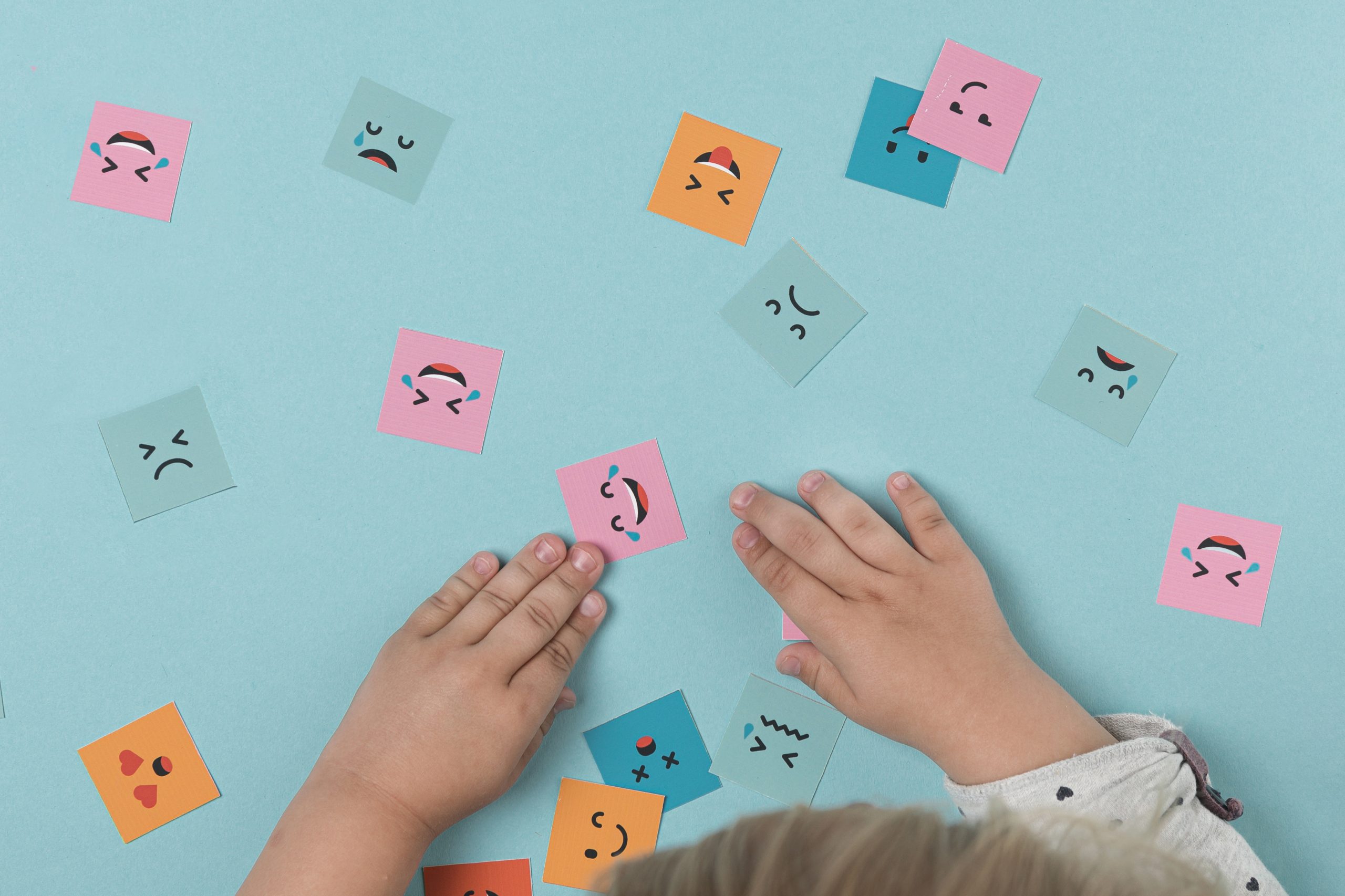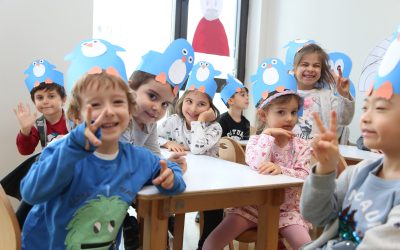Emotions play a central role in how children make sense of the world and connect with others. Basic emotions such as happiness, sadness, anger, fear, and surprise are experienced intensely during the preschool years. However, recognizing these emotions, expressing them in healthy ways, and regulating them when necessary are not innate skills; they are abilities that develop over time.
Children who can recognize and express their feelings not only understand themselves better but also build stronger connections with those around them. These skills are critical for healthy social relationships, problem-solving, developing empathy, and building self-confidence.

Emotional Development in Early Childhood
- Ages 2–3: Children begin to distinguish basic emotions but usually express them through behaviors (e.g., crying, shouting, pushing).
- Ages 3–4: They start to name their emotions. Phrases like “I’m angry” or “I’m happy” appear, and they begin to make simple cause-and-effect connections.
- Ages 4–5: Awareness of others’ feelings and empathy emerge. For example, seeing a friend cry may make them feel sad or prompt them to offer comfort.
- Ages 5–6: They start to grasp the complexity of emotions, understanding that it is possible to feel both excited and worried at the same time.
The Role of Recognizing Emotions in Child Development
Recognizing emotions is a key step in children’s ability to understand both themselves and others. Children first learn to identify their own feelings, which helps them make sense of their inner world, and then gradually notice and interpret the emotions of others.
- Self-Confidence: A child who understands their feelings can express themselves more clearly, strengthening their confidence.
- Empathy: Recognizing others’ emotions enhances the ability to empathize.
- Problem-Solving: By noticing and managing feelings like anger or sadness, children can come up with constructive solutions.
- Academic Success: Children with stronger emotional regulation skills can sustain attention for longer periods and become more open to learning.
Thus, recognizing emotions provides the foundation for lifelong communication, empathy, and self-regulation skills.
The Benefits of Emotion Regulation
Emotion regulation is the ability to notice one’s feelings, express them appropriately, and calm down when necessary. This skill directly impacts children’s daily lives and relationships:
- School Success: A child who can regulate emotions can stay focused and return to learning after conflict.
- Peer Relationships: Managing anger and frustration supports sharing, turn-taking, and cooperation.
- Self-Confidence: Regulating emotions increases confidence and the ability to express oneself.
- Social Adjustment: Children become more adaptable in group play and teamwork.
Challenges in Expressing Emotions and Solutions
- Limited Vocabulary
- Challenge: Children may lack the words to describe their feelings.
- Solution: Use emotion cards, mirrors, and storybooks to teach feeling words.
- Intense Emotions
- Challenge: Strong feelings like anger, fear, or frustration may overwhelm them.
- Solution: Create a calm-down corner, practice deep breathing, or offer comforting routines like singing or hugging.
- Egocentrism
- Challenge: Young children often focus only on their own perspective.
- Solution: Play empathy games (e.g., “What do you think your friend is feeling right now?”).
- Social Difficulties
- Challenge: In group play, children may push or shout instead of using words.
- Solution: Use role-play to practice alternatives (“What can you say when you want the toy?”).
- Suppressed Emotions
- Challenge: Children who are told not to show feelings may internalize stress.
- Solution: Use validating language like “It’s okay to feel sad” to encourage healthy expression.
The Family’s Role in Emotional Learning
Parents are children’s first emotional teachers. How families model and respond to emotions directly shapes development.
- Modeling: Demonstrate healthy ways to show and manage emotions. (“I feel tired today, so I need some quiet time.”)
- Labeling: Put words to children’s feelings (“You seem upset, I can see that”).
- Acceptance: Normalize all feelings, even negative ones. (“It’s okay to be angry.”)
- Positive Feedback: Praise when children use words to express emotions. (“Thank you for telling me how you feel.”)
Encouraging Emotional Expression: Helpful Phrases
- “What are you feeling right now?” → Promotes self-awareness.
- “I understand you, and it’s normal to feel this way.” → Validates emotions.
- “Thank you for telling me; it’s great to share your feelings.” → Encourages openness.
- “When you feel angry, what can you do? Let’s think together.” → Builds problem-solving skills.
Misunderstood Emotions
Some common phrases can cause children to suppress their emotions and negatively affect their emotional development. For example:
- “Don’t cry, big kids don’t cry.”
- “Feeling angry is wrong.”
Such statements prevent children from both understanding their own emotions and expressing them appropriately. When children hear these phrases, they may think, “It’s wrong to express my feelings” and begin to suppress them. This can harm both empathy development and self-awareness.
The effects of misunderstood emotions are not only short-term; in the long run, children may struggle to express themselves, show uncontrolled outbursts of anger or sadness, or, on the contrary, completely internalize their emotions. Especially during the preschool years, children are still learning to manage and share their feelings. Therefore, misleading messages can directly harm their learning process.
The right approach:
- Parents and teachers should accept that all emotions are normal and provide opportunities for children to express them appropriately.
- Even emotions that seem negative are natural experiences; for example, anger, frustration, or sadness are normal feelings.
- It is important to provide children with a safe environment where they can share what they feel. Using phrases like “You are sad, it’s very normal to feel this way, and you can tell me about it” makes it easier for children to recognize, label, and manage their emotions.
In this way, children learn both to understand themselves and others, their emotional intelligence develops, and they build healthier relationships in social settings.
Teacher and Parent Collaboration
Using the same language at home and at school provides a sense of security for the child. When children express their emotions with similar words both at home and in class, they feel safer, and their learning process accelerates:
- Naming emotions with the same words at home and at school helps children reinforce concepts. For example, in a moment of anger, both at home and in class, adults can say: “It’s normal to feel angry, let’s take a deep breath and calm down.”
- Consistently applying regulation strategies at home and at school strengthens the child’s sense of security. The child knows what to do in a given situation and manages emotions more consciously.
- This collaboration strengthens children’s emotional learning process and helps them feel more comfortable and safe at school.
Emotion Activities at Home
- Emotion Cards Game
- Prepare cards showing different facial expressions.
- Ask the child to guess which emotion is being expressed.
- Example: “How does this child feel? Why might they feel this way?”
- Keeping an Emotion Journal
- At the end of the day, encourage the child to draw or write a few words about how they felt.
- Both positive and negative emotions can be recorded.
- Example: “When were you the happiest today? Why?”
- Role-Play and Drama
- Act out different scenarios to practice appropriate emotional responses.
- Example: Play the role of a child who wants a friend’s toy and discuss how sharing can be handled.
- Breathing and Calming Exercises
- Practice simple techniques such as deep breathing or counting to five during moments of anger, anxiety, or sadness.
- Tell the child: “You can calm your anger by doing this.”
- Creating Stories with Emotions
- Encourage the child to make up short stories involving different emotions.
- Discuss how the characters feel to develop empathy and emotional awareness.
- “How Do You Feel Right Now?” Question
- Routinely ask the child about their feelings throughout the day.
- Example: Before meals, after playtime, or when coming home: “How do you feel right now? Would you like to tell me about it?”
- Books and Stories
- Analyze the emotions of story characters to help children understand their own and others’ feelings. Discussing events in stories supports empathy and social awareness.
- Breathing Exercises
- Teaching deep breathing during moments of anger or anxiety helps children calm down. These exercises strengthen self-control and emotional regulation skills.
- Role-Play
- Practicing appropriate emotional responses in different situations reinforces social skills. For example, the child can role-play what to say when they want to borrow a toy from a friend.




